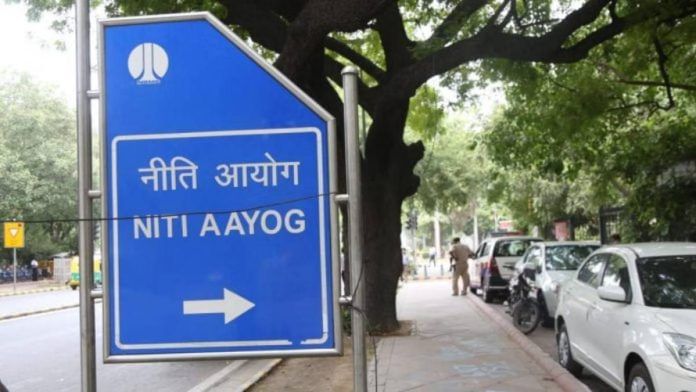New Delhi: India’s services sector growth has been geographically uneven as the southern states have emerged as major service-oriented economies in comparison to the rest of India, according to a NITI Aayog report.
Titled ‘India’s Services Sector: Insights from GVA Trends and State-Level Dynamics’, the report released Tuesday says that “states such as Karnataka, Maharashtra, Tamil Nadu and Telangana have developed globally competitive hubs anchored in high-value, tradable, and knowledge-intensive services such as IT, finance, professional services and digital platforms”.
“Collectively, they contributed around 40 percent of India’s total services output in 2023-24,” it adds.
Overall, in 2024-25, India’s services sector contributed around 55 percent of gross value-added (GVA), surpassing both primary (16.7 percent) and secondary (28.8 percent) sectors. It also accounts for around 30 percent of total employment, states the report.
GVA is the value of all services produced in an economy after reducing the cost of intermediate goods and services. Gross State Value Added (GVSA) is the sum of all values added by all producers within a specific state. The primary and secondary sectors refer to agriculture and manufacturing, respectively.
At the launch of the report, NITI Aayog CEO B.V.R Subrahmanyam called on states to formulate their own strategies to promote the service sector.
“If individual states develop strategies, then there will be no state in India which cannot capitalise on the service sector,” he said.
According to the report, states like Gujarat, Chhattisgarh and Madhya Pradesh, while having a dominant position with regard to the manufacturing sector, demonstrate relatively lower levels of service-oriented growth.
On the other side of the spectrum are states like Odisha and Assam, which saw their share of services in GSVA decline between 2011-12 and 2023-24, thereby suggesting limited transition from agriculture and extractive activities.
“Odisha’s services share declined from 38.5 percent to 34.9 percent, while Assam fell sharply from 46.5 percent to 34.3 percent, possible underperformance in services sector growth,” says the report.
In contrast, smaller north-eastern states like Meghalaya, Manipur, and Nagaland saw gains in their service sector contribution, driven by expansion of public services, health, education, and infrastructure investments under central schemes, according to the report.
“Meghalaya’s rise from 44.7 percent to 63.2 percent, and Manipur’s increase from 64.8 percent to 72 percent, illustrate the power of state-level policy shifts and public sector-led growth in transforming service output even in geographically constrained economies,” it says.
A distinctive case among states is Bihar, which has the lowest per capita income but maintains a relatively high average services share of 58 percent. According to the report, the divergence suggests that the services sector in the state may be primarily characterised by lower-productivity and more informal segments.
Traditional services like trade and repair account for 27.8 percent of services share towards GSVA for Bihar, followed by Other Services (education, community services) with 20 percent share.
Also Read: India’s service sector PMI sees marginal fall in November; hiring grew at fastest pace since 2005
State-wise policy recommendations
To foster more balanced regional growth in the services sector, the think-tank recommends unlocking policy support for states by grouping them based on their average services sector share towards GSVA.
States are divided into four categories: service share of above 55 percent, between 50 percent and 55 percent, between 40 percent and 50 percent and below 40 percent.
The states with average service share below 40 percent are Himachal Pradesh, Madhya Pradesh, Uttarakhand, Odisha, Gujarat and Chhattisgarh.
For these, NITI Aayog recommends embedding services in industrial ecosystems and workforce skills in community-based platforms. It also suggests establishing core infrastructure for rural and resource-linked services through targeted expansions, service delivery upgrades and digital connectivity.
For Haryana, Punjab, Uttar Pradesh, Jharkhand, Andhra Pradesh, Rajasthan and Assam that have average services share between 40 percent and 50 percent, it suggests leveraging regional strength to build specialised service clusters within sectors like logistics, tourism, ports and creative micro-small medium enterprises.
For Tamil Nadu and West Bengal, states with services share between 50 percent and 55 percent, the NITI Aayog recommends embedding IT-enabled services in industrial clusters and developing logistics hubs. It also suggests opening centres related to tech-skilling, vocational training and future-ready skilling.
Finally, for Delhi, Chandigarh, Karnataka, Kerala, Telangana and Maharashtra, having services share of more than 55 percent, the report recommends developing tier 2/tier 3 cities with innovation zones and services linked to research and development centres.
It also suggests that these states “scale global service export through export-ready digital infrastructure, innovation-led clusters, and global branding and trust systems”.
On Tuesday, NITI Aayog also released the report ‘India’s Services Sector: Insights from Employment Trends and State Level Dynamics’.
(Edited by Nida Fatima Siddiqui)
Also Read: Modi govt considering NITI Aayog plan to change how bidders are selected for procurements






